Saturday, May 27, 2006
Scout Camp
I'm going to bend the first and second rules about scout camp here.
We left for scout camp in eastern Washington Monday morning and headed back home around noon on Friday. I think I got about 10 hours of sleep while I was over there.
During the days there was a gradual build up of skills: learning to "sink and fade", camo up, choose good hiding places, etc. We were broken up into four clans and at night the game was on. Some people just slept, others were on guard and some went and scouted (or at least tried to fine) the camps of other clans. Most people did some combination of those three things. Each clan had a flag posted up so it was a challenge to go and put things on their flag or mess around a little with their gear without getting caught. In the evenings there was often an organized activity such as stalking up on some people (the instructors in character) around a fire, get as much info about them as we could, grab some "booty bags" stashed around the area and not get caught. For me, those types of events were probably the most fun. I don't remember ever being so creaped out (in recent history anyway) and keeping on being bold(ish) anyway. Definitely an edge stretching experience. It was also fun to see how many times people would walk by when I was motionless in plain view 10 feet away. It wasn't too surprising when it happened when it was dark out, but it happened a couple of times in broad daylight. I probably did the same kind of thing at times and it really makes me think about how often I probably walk by wildlife without noticing it there.
Next week will be a 4 day survival trip in which we are only allowed to bring our clothes, no knives, lighters, etc. allowed. Should be quite an experience, but I hope it dries up a little before hand.
Sunday, April 30, 2006
East side
The first day we explored along the edge of a canyon with a nearby stream winding between some small sand dunes.

I'm not sure what kind of flowers these are and unfortunately do not have a good plant guide for that side of the mountains, but it looks like it is in the pea family.
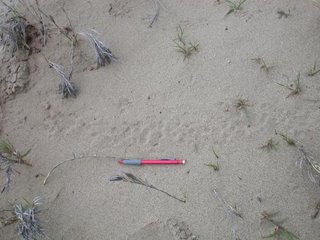
I don't know what these tracks are either. I would guess a medium sized rodent as they wandered through the sand often ending in holes a couple of inches across.
That evening I harvested a mullein stalk and got an aspen branch and with a little help got my first coal on a hand drill kit that had been wild gathered that day. That was fun, but it is still a different challenge over here on the west side. I think I could do it if I found a downed big leaf maple of the right size (though maybe not if it had been wet a lot recently), but that is not a given.
The next day we spent in a smaller canyon with its own set of interesting things. There were hawks nesting, more flowers and tons (literally) of beaver sign.
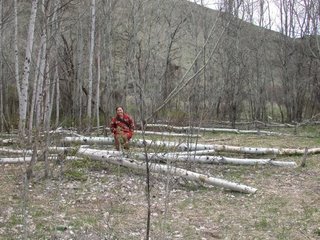
All the fallen trees were done in by beavers. I wonder how much longer the stand will last around there at the rate they seem to be going through them.
A small group of us hiked up to the canyon rim and explored around. While digging a lily bulb we turned up this Jerusalem Cricket. Apparently they eat bulbs - maybe we stole the meal out of his mouth.

I had a great time on the trip, it was a good reminder of how fun it can be to get out with a group of people and how much more can be seen with that many eyes spread out over the landscape.
Saturday, April 15, 2006
Knotweed
 The Friday after the knotweed expedition mentioned in the previous post we went out for more. This time the four of us harvested around 40 pounds of it. That made for a busy day of processing on Saturday. With the addition of a couple of extra cooks, we ended up making 10 different knotweed dishes - most of them more or less invented on the spot. We made sweet sauce, two savory sauces, juice, stir fry, custard, a tart, a quiche-like fold over, a fruit and granola mixture, and steamed some. I was pleased with the outcome in almost all cases.
The Friday after the knotweed expedition mentioned in the previous post we went out for more. This time the four of us harvested around 40 pounds of it. That made for a busy day of processing on Saturday. With the addition of a couple of extra cooks, we ended up making 10 different knotweed dishes - most of them more or less invented on the spot. We made sweet sauce, two savory sauces, juice, stir fry, custard, a tart, a quiche-like fold over, a fruit and granola mixture, and steamed some. I was pleased with the outcome in almost all cases.Over the course of that Saturday I ended up consuming a lot of knotweed. It is possibly worth noting that, even when still young, knotweed has a lot of fiber which may or may not be a welcome contributor to your digestive system when taken in large quantities. Let's just say I had no trouble with "regularity" that Sunday. (Though I've had knotweed many times in many forms in the past, this was the first time it had such an effect on me.)
Wednesday, April 05, 2006
Springing out of Winter
Anyhow... To spring!
The day after the vision quest wrapped up I went out with some friends and took a leasurely expedition to harvest knotweed which we used to make custard, sauce, juice and stir fry. Yesterday a couple of us harvested nettles to make nettle "chips" and today I harvested dock, nettle, and dandelions to put in a stir fry. There are several wild flowers now in bloom as well, including coltsfoot, violet, huckleberry, and trillium.
Tomorrow I'm planning on looking for fish.
Wednesday, March 08, 2006
Bobcats in California
We stopped in Sunol for two nights. It was a pleasant way to break up our drive and get acclimated to California. We were given the day to explore, swim, nap, or whatever we felt like doing. Several of us decided to hike to the top of flag hill. It provided a great view of the valley and hills as well as being a great place to take a short nap in the sun. Some of us decided to take an alternate route back down, and while walking down a little ridge I noticed a gray shape moving next to a tree. I got the attention of the person ahead of me and I tried to show him where the shape was - it blended in with the tree very well when it wasn't moving. Eventually he saw where it was, but it moved out of sight by the time the rest of the crew caught up. We were pretty excited, but not entirely sure what it was. Fortunately we got a few more glimpses of it as it slowly walked around, stopping a couple of times to sit and then scratch. With these sightings we were sure it was a bobcat. It walked out of sight again, and we excitedely decided to go over and see if we could find any tracks/figure out what it had been doing. Unfortunately there was a bit of a ravine between where we were and where it had been, so we walked around the edge of the ravine until it became narrow enough that we could cross over. Of course just as we were getting to the other side someone realized that the bushes we had been skirting (and had we brushed up against or even grabbed some for support?) were poison oak. Huh. We scrubbed our arms and hands with dirt in hopes of getting rid of any excess oil and kept on our way, figuring that what we had seen was probably worth a little poison oak if we did end up getting it.
Hiking in groups can have advantages and disadvantages for seeing wildlife. With a bunch of people, it is more likely that one of them will see what's there. On the other hand, a bunch of people are more likely to be noisy and scare away animals before anyone has a chance to see them. Our group was reasonably good about being quite (once we had a concrete reason to be quite anyway), and I'm sure grateful for the extra sets of eyes.
When we finally got back to where we had seen the bobcat, most of us were looking around for where we had seen it scratching, but Marcus was looking around and saw it walk over the rise of the hill in front of us. We decided to postpone looking at "boring old" cat scratches made only minutes earlier in favor of trying to see more of the cat. Up the hill we headed. Marcus thought he had seen it head off to the right so we angled off that way and looked across the wide open fields, but didn't see it anywhere. Surely it didn't head to the left because there were quail hanging out in the road that was there and they didn't seem at all alarmed (apart from a little concern about keeping some distance from us). After looking around to the right for awhile Theodore and Susan (who were moving slower and stealthier than the rest of us) said they thought they saw something moving off further to the left. We had pretty much given up on the right so we headed to the left along the road toward a little picnic area near a big barn. Rees was up ahead and got my attention - indicating that he had seen something. I got up to where he was, but was puzzled. What was he looking at? The upright chunk of wood next to the barbeque pit? Slowly though the log transformed into a bobcat. It was amazing. Just sitting there 30 yards away. Looking at us occasionaly but unconcerned. After a few minutes it got up and walked off towards the barn. Marcus, Rees and Susan decided to head around the other side of the barn to see if they could see it as it walked past. I went to look at where it had been sitting (right next to a critter-sized tunnel in the ground) and continued on, following the direction the cat had gone. As I was approaching Theo also was coming up along that side of the barn. The angle I took allowed me to just see into the barn and I saw that the bobcat was sitting in there, so I motioned to Theo and we crept up and watched it through a hole left by a missing board in the side of the barn. A noise on our part alerted the bobcat to our presence, so it spent some time looking at us. I hurriedly got my camera ready, and the next thing I know - it's walking in our direction! I had my camera out and ready as it skirted the corner of the barn and walked around us - right through my shadow about 10 feet away! Well, I snapped as many pictures as I could as it walked off down the hill. The rest of the group came around the barn and we talked over the events and realized that they had poked around their corner of the barn and that's when the bobcat headed in our direction. We decided we would let the bobcat have some peace and rather than continue to trail it, we explored where it had been. In the barn it had also been sitting next to some animal holes, and by the look of the tracks in the dust, it went by there fairly often. It was starting to get late, so we were in a bit of a hurry, but we went back and looked at where we had first seen it and found a couple of latrine areas that it appeared to visit regularly. One of the places it had scratched appeared to have been to spread scent from a recent scat; one of the other scratches was over an even fresher scat that we figured it had probably produced in the period of time we were watching it.

(Click picture to enlarge)
Sunday, February 26, 2006
Bow making
 Shortly before our trip to California, we had the opportunity to make our own bows. We started out with a hickory board pre-cut by our instructor into a general bow shape. Our task was to then remove wood using files and sandpaper until we were satisfied with the result. Rounding the corners, smoothing the faces and making notches for the string were straightforward tasks, but when we finished those we were left with the difficult part of bow making: tillering. Tillering is the process of making the top and bottom limb of the bow even in strength. If one limb is stronger than the other it can have a detrimental affect on how the bow shoots. You can see that my bow is not evenly balanced - the limb at the bottom of the picture (which is actually the top of the bow) curves more gently than the limb at the top of the picture. The way to balance that out would be to weaken the stronger limb by shaving wood from its belly (the inner surface). I chose not to do that for two reasons. One is that the instructor said that some people prefer to have the top limb a bit weaker because the balance point of the bow is actually closer to the top than the bottom so the bottom limb has farther to travel so could stand to be stronger (at least that's what I understood from what was said). The second reason was that initially the limbs were uneven in the opposite direction and I took a lot of wood off (testing periodically) until suddenly the limbs were reversed in strength. I took a little bit of wood off the now stronger limb, but it didn't appear to have much of an affect and I was afraid the same thing would happen and I would end up with a bow much weaker than I wanted.
Shortly before our trip to California, we had the opportunity to make our own bows. We started out with a hickory board pre-cut by our instructor into a general bow shape. Our task was to then remove wood using files and sandpaper until we were satisfied with the result. Rounding the corners, smoothing the faces and making notches for the string were straightforward tasks, but when we finished those we were left with the difficult part of bow making: tillering. Tillering is the process of making the top and bottom limb of the bow even in strength. If one limb is stronger than the other it can have a detrimental affect on how the bow shoots. You can see that my bow is not evenly balanced - the limb at the bottom of the picture (which is actually the top of the bow) curves more gently than the limb at the top of the picture. The way to balance that out would be to weaken the stronger limb by shaving wood from its belly (the inner surface). I chose not to do that for two reasons. One is that the instructor said that some people prefer to have the top limb a bit weaker because the balance point of the bow is actually closer to the top than the bottom so the bottom limb has farther to travel so could stand to be stronger (at least that's what I understood from what was said). The second reason was that initially the limbs were uneven in the opposite direction and I took a lot of wood off (testing periodically) until suddenly the limbs were reversed in strength. I took a little bit of wood off the now stronger limb, but it didn't appear to have much of an affect and I was afraid the same thing would happen and I would end up with a bow much weaker than I wanted.Most of the class was able to finish their bows with a bit of time left over to shoot them. We watched a video on instinctive shooting and went to it. I was able to shoot relatively accurately from around 5 to 10 paces (the distance recommended to us for starting out at).
It was a long couple of days with a lot of work and some large batches of frustration, but it was a really good feeling to come out of it with a working bow made by my own hands.
Tuesday, February 21, 2006
Aplodontia Hike
Back in January I went on a hike to Cherry Falls (near Duvall) with a couple of friends. The trip to the falls was fairly uneventful, but after we left the falls we decided to be adventurous and turn right instead of going back the way we came. We thought the logging road might connect with some that we were familiar with or we could just bushwack through the brush and woods to get back to where we wanted to be.


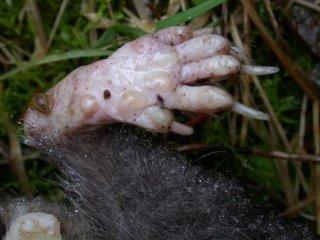 Early along the way we came upon a dead Aplodontia. Before I came out for school I had never heard of an aplodontia, but they are pretty common around here (they are also known as mountian beaver though they aren't really a type of beaver). They live in burrows and tend to be active at night so they aren't commonly seen (this was the first time I had seen one alive or dead.)
Early along the way we came upon a dead Aplodontia. Before I came out for school I had never heard of an aplodontia, but they are pretty common around here (they are also known as mountian beaver though they aren't really a type of beaver). They live in burrows and tend to be active at night so they aren't commonly seen (this was the first time I had seen one alive or dead.)We tried to figure out what killed it, but remain stumped. There didn't seem to be any obvious wounds from predators or vehicles, so we thought maybe disease. I've also seen a lot of shrews dead in the middle of trails with no apparent wounds... A definite mystery.
It was cool to see the different parts up close. You can see here the big digger claws of the front foot and the weird bumps on the hind which would probably show up in good tracks.
After a good long look at the aplodontia we moved on. We were headed generally north (with several switchbacks) and wanted to head mostly west and a little north. There was an occasional trail or road headed west that we explored, but none of them panned out. Eventually we came to a gate by a clearcut. Nearby the gate was a sign warning that it was a test zone for fertilizing with treated sewer sludge. I guess maybe it's good that they're using waste in a productive manner, but it certainly didn't make me eager to explore around off of the road in that area.
Time was progressing and I was getting a little tired. We passed a few westerly roads that looked unpromising - there were several small timber sale locations in the area that roads would go to and stop - and were getting a little worried about getting out before dark. At probably close to 3 (this being when/where it gets dark around 5) Matt suggested that if within 15 minutes we didn't join up with a road we recognized that we should head back the way we came. Though I knew it was the safer option, I was dreading that possibility because we had hiked an extra few miles already, I was getting tired, and even if we did head back that way it would probably be dark before we got back. Fortunately about 10 minutes later we joined into a road that Matt and I had been on back on the day we trailed the cougar tracks. From there we had an uneventful, though still fairly long (probably an additional 2 miles) walk back.
Tuesday, January 31, 2006
A day of wandering
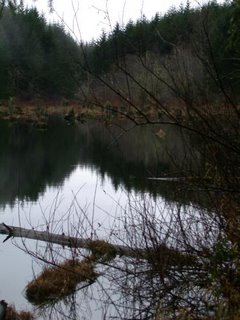 One of the first days of the term we broke up into our new clans and went on wanders. Trestle swamp, pictured here, ended up being our destination in the sense that we ate lunch there and more or less started heading back (by a different route) when we left it. It was my first time there and we saw what we think was an otter. We then built a fire, which was quite a challenge since we were in the middle of a long streak of consecutive rainy days in the area, but we finally managed with the proper application of pitch.
One of the first days of the term we broke up into our new clans and went on wanders. Trestle swamp, pictured here, ended up being our destination in the sense that we ate lunch there and more or less started heading back (by a different route) when we left it. It was my first time there and we saw what we think was an otter. We then built a fire, which was quite a challenge since we were in the middle of a long streak of consecutive rainy days in the area, but we finally managed with the proper application of pitch.
 We found this amazing skeleton earlier in our wander. We were surprised by how little it had been disturbed. The best explanation we could think of was that it died of some disease which made it unappealing to other animals. Though we had some identification guesses, none of them seemed to fit the skeleton. It wasn't until we got back to look at some field guides that we decided it was a possum.
We found this amazing skeleton earlier in our wander. We were surprised by how little it had been disturbed. The best explanation we could think of was that it died of some disease which made it unappealing to other animals. Though we had some identification guesses, none of them seemed to fit the skeleton. It wasn't until we got back to look at some field guides that we decided it was a possum.
Thursday, January 12, 2006
Rain
It's been raining quite a bit in the Seattle area lately and now near Duvall many fields are now large puddles. Cherry Valley which borders Snoqualmie Valley near here is affectionately known as Cherry Lake at times like this. One of the fields that borders the highway that runs through Duvall has had several swans swimming over it the past few times I've driven by. The right picture was taken this morning.

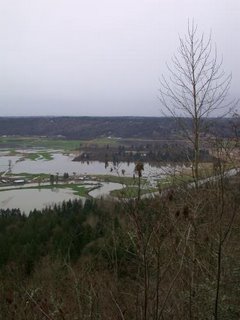
Sunday, January 08, 2006
Winter Break
 Near the beginning of break I had an enjoyable trip to some hotsprings near North Bend (Washington). I don't remember the name of them, but they were nice, out of the way, run by a non-profit group. There was a long stretch of gravel road - about 16 miles of it - leading up to the trail. We would have had a lot longer to walk if we hadn't had a 4wd truck. There was a log to be driven over, several fairly sizable pot holes, and snow to slog through. Once we got to the parking area there was a short walk to the campground - short if you are willing to wade through a knee deep icy cold river anyway, otherwise you can take the 3 mile walk around.
Near the beginning of break I had an enjoyable trip to some hotsprings near North Bend (Washington). I don't remember the name of them, but they were nice, out of the way, run by a non-profit group. There was a long stretch of gravel road - about 16 miles of it - leading up to the trail. We would have had a lot longer to walk if we hadn't had a 4wd truck. There was a log to be driven over, several fairly sizable pot holes, and snow to slog through. Once we got to the parking area there was a short walk to the campground - short if you are willing to wade through a knee deep icy cold river anyway, otherwise you can take the 3 mile walk around.The campground and hotsprings were in a lovely forest with a creek running down one side. Along with several large trees there is a huge doug-fir on the trail up to the springs. The main pool is set back in a cave that goes back probably around twenty feet. It is difficult to take the heat in that pool for long periods of time, but the middle pool, while much smaller is a very nice temperature, the bottom pool is on the cool side though comfortable and there is a cold water pool off to the side for those feeling adventurous.
 After the hot springs trip I drove over to Idaho to spend some time with family and friends. While on the farm I went out with my dad and collected a bunch of different woods to try friction fires with.
After the hot springs trip I drove over to Idaho to spend some time with family and friends. While on the farm I went out with my dad and collected a bunch of different woods to try friction fires with.